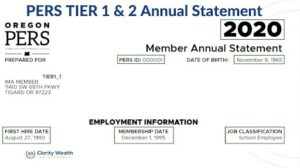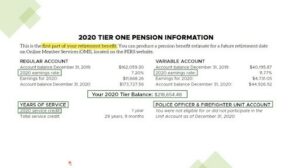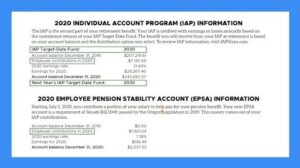by Kay Dee Cole, CFP®, RLP®, CeFT® and Dr. Kim Hall, CFP®, RLP®, GFP®
The Public Employee Retirement System, also known as PERS, is the retirement system used for most public service workers of Oregon. Founded in 1946, PERS allows employers to provide retirement benefits to their workers in the form of a pension, death benefits, and retiree health insurance. The Oregon Savings Growth Plan (OSGP) is the 457 plan in addition to PERS.
PERS is now only used for individuals hired prior to 2003 – workers hired after that are part of the Oregon Public Service Retirement Plan, or OPSRP.
If you were hired after 2003, click here to jump over to our OPSRP explainer article + video.
Members of PERS can expect to receive an annual statement – but what exactly can that statement tell you, and how can you use that information to better plan for your future retirement?
We’re walking you through the different sections of your Tier 1 and 2 annual PERS statement to give you all the details you need for making informed financial planning decisions.
How to Read Your PERS Statement
For the purposes of this tutorial, we’ll be referencing a 2020 PERS Tier 1 & 2 Annual Statement.
The first section of your statement will include all of your general information, such as your address, birth date, and PERS ID. Your ID number is used for all communications between you and PERS – you’ll find it on all of your statements and use it any time you fill out a form for PERS.

Below that, you’ll see your first hire date, membership date, and job classification.
Your membership date differs from your first hire date in that instead of representing the first day you began work, it tells you when you were first eligible for PERS retirement contributions. For most, the membership date will fall about six months after their first hire date. For Tier Two members, you may be able to “purchase” your six month waiting period. This is done when you establish your retirement date.
Pension Information
Your pension information is the first part of your retirement benefit. It tells you what you currently have in your Tier 1 pension. The statement is based on information from your employer and annual earnings credited as of Dec. 31 of the prior year. It is not based on the date you receive the statement.
There are two possible types of accounts here:
- A regular account, which has a generally fixed earnings rate
- A variable account, which has an earnings rate based on market fluctuations

The variable account is considered a higher risk option that generally also offers higher reward. You might have a variable account, a regular account, or a combination of the two. The numbers here don’t necessarily represent your total pension, though, since it doesn’t include what PERS will contribute. Members have an opportunity to choose a fixed pension amount or stay with a variable account at retirement. Those that chose the variable pension will have variable amounts each month based on the investment returns. You have 60 days after retirement to change back to a fixed amount.
Beneath your balance, you’ll find your service credits. The total service credit is the number PERS will use when calculating your retirement benefits. To the right, you’ll find the “Police Officer and Firefighter Unit Account” – unless you have worked in either of those professions, you can ignore that section.
The pension portion of your benefit is called a defined benefit pension. This means your pension is not set by the balance of your account but based on a formula.
Find out why people choose Clarity Wealth: 3 Real Quotes from Real Clients on Why They Love Clarity
The Individual Account Program
The second part of your retirement benefit is called the Individual Account Program, or IAP. This is may be funded by you or your employer. Usually 6% goes into the IAP, unless your salary is above the monthly threshold.

This section can tell you your IAP account balance, average return, and target date funds. Your target date is automatically set based on your birth year, but you can request to change that target date in order to invest more or less aggressively.
When you retire and receive your pension, you’ll also have options for what to do with your IAP. You could:
- Rollover your funds into an IRA
- Rollover the amount into an Oregon Savings Growth Plan
- Take distributions
It’s important to note that your IAP must be rolled over or distributed up to 15 years from retirement.
The Employee Pension Stability Account
New in 2020, the Employee Pension Stability Account, or EPSA, is a portion of your salary used to help pay for your pension benefits. It’s based on your salary, and many may find they’re not paying anything into the EPSA at all.
But if you are over the set monthly threshold (which varies), you’ll be paying 2.5 % of your IAP into this account to fund your future pension benefit. If you see this section on your annual statement, you are paying into it. For 2022 the threshold is a monthly salary of $3,333.
Oregon Savings Growth Plan (OSGP)
The Oregon Savings Growth Plan is an additional way to save for retirement and is not part of the IAP or Pension. This is a separate 457 supplement plan that you can opt in to and save even more for retirement. To learn more about the OSGP, click here.
Plan Your Retirement with Clarity
Knowing the ins and out of your retirement can be tricky – that’s why we’re here to help. From reading your PERS statements to mapping out a plan to reach your unique retirement goals, Clarity Wealth Development can help you get on track. Click here to schedule a meeting with Clarity today.



